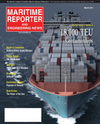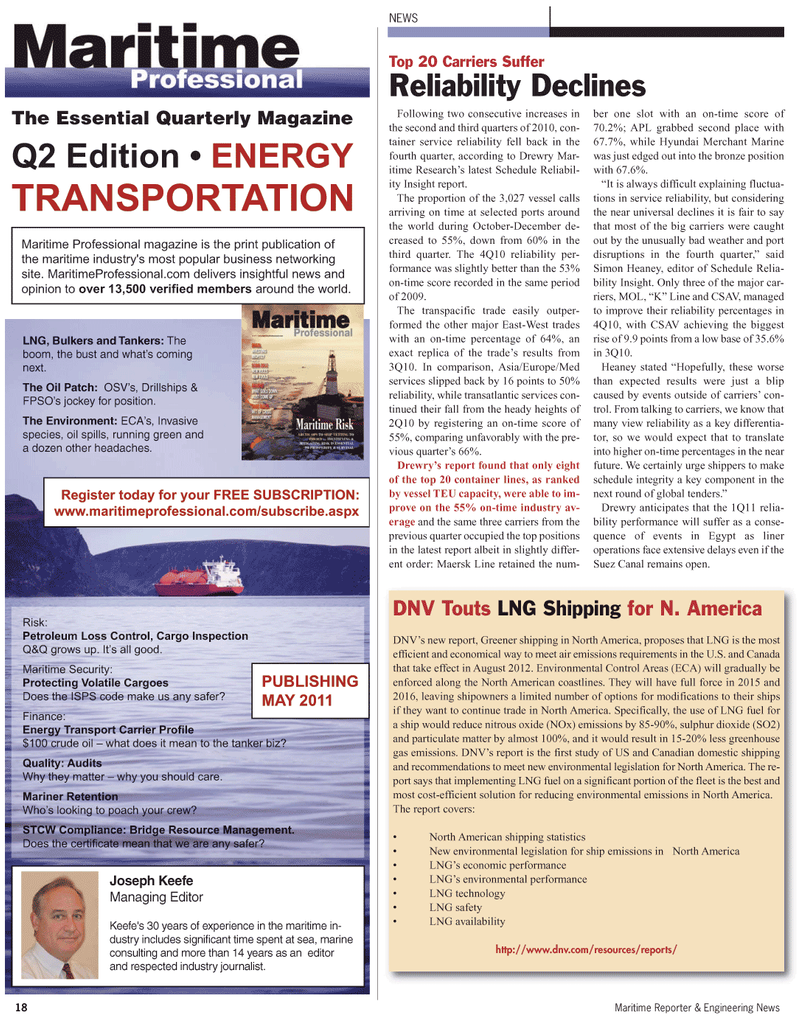
Page 18: of Maritime Reporter Magazine (March 2011)
Ship Repair & Conversion
Read this page in Pdf, Flash or Html5 edition of March 2011 Maritime Reporter Magazine
18 Maritime Reporter & Engineering News
NEWS
DNV Touts LNG Shipping for N. America
DNV’s new report, Greener shipping in North America, proposes that LNG is the most efficient and economical way to meet air emissions requirements in the U.S. and Canada that take effect in August 2012. Environmental Control Areas (ECA) will gradually be enforced along the North American coastlines. They will have full force in 2015 and 2016, leaving shipowners a limited number of options for modifications to their ships if they want to continue trade in North America. Specifically, the use of LNG fuel for a ship would reduce nitrous oxide (NOx) emissions by 85-90%, sulphur dioxide (SO2) and particulate matter by almost 100%, and it would result in 15-20% less greenhouse gas emissions. DNV’s report is the first study of US and Canadian domestic shipping and recommendations to meet new environmental legislation for North America. The re- port says that implementing LNG fuel on a significant portion of the fleet is the best and most cost-efficient solution for reducing environmental emissions in North America.
The report covers: • North American shipping statistics • New environmental legislation for ship emissions in North America • LNG’s economic performance • LNG’s environmental performance • LNG technology • LNG safety • LNG availability http://www.dnv.com/resources/reports/
Following two consecutive increases in the second and third quarters of 2010, con- tainer service reliability fell back in the fourth quarter, according to Drewry Mar- itime Research’s latest Schedule Reliabil- ity Insight report.
The proportion of the 3,027 vessel calls arriving on time at selected ports around the world during October-December de- creased to 55%, down from 60% in the third quarter. The 4Q10 reliability per- formance was slightly better than the 53% on-time score recorded in the same period of 2009.
The transpacific trade easily outper- formed the other major East-West trades with an on-time percentage of 64%, an exact replica of the trade’s results from 3Q10. In comparison, Asia/Europe/Med services slipped back by 16 points to 50% reliability, while transatlantic services con- tinued their fall from the heady heights of 2Q10 by registering an on-time score of 55%, comparing unfavorably with the pre- vious quarter’s 66%.
Drewry’s report found that only eight of the top 20 container lines, as ranked by vessel TEU capacity, were able to im- prove on the 55% on-time industry av- erage and the same three carriers from the previous quarter occupied the top positions in the latest report albeit in slightly differ- ent order: Maersk Line retained the num- ber one slot with an on-time score of 70.2%; APL grabbed second place with 67.7%, while Hyundai Merchant Marine was just edged out into the bronze position with 67.6%. “It is always difficult explaining fluctua- tions in service reliability, but considering the near universal declines it is fair to say that most of the big carriers were caught out by the unusually bad weather and port disruptions in the fourth quarter,” said
Simon Heaney, editor of Schedule Relia- bility Insight. Only three of the major car- riers, MOL, “K” Line and CSAV, managed to improve their reliability percentages in 4Q10, with CSAV achieving the biggest rise of 9.9 points from a low base of 35.6% in 3Q10.
Heaney stated “Hopefully, these worse than expected results were just a blip caused by events outside of carriers’ con- trol. From talking to carriers, we know that many view reliability as a key differentia- tor, so we would expect that to translate into higher on-time percentages in the near future. We certainly urge shippers to make schedule integrity a key component in the next round of global tenders.”
Drewry anticipates that the 1Q11 relia- bility performance will suffer as a conse- quence of events in Egypt as liner operations face extensive delays even if the
Suez Canal remains open.
Top 20 Carriers Suffer
Reliability Declines
LNG, Bulkers and Tankers: The boom, the bust and what’s coming next.
The Oil Patch: OSV’s, Drillships &
FPSO’s jockey for position.
The Environment: ECA’s, Invasive species, oil spills, running green and a dozen other headaches.
Risk:
Petroleum Loss Control, Cargo Inspection
Q&Q grows up. It’s all good.
Maritime Security:
Protecting Volatile Cargoes
Does the ISPS code make us any safer?
Finance:
Energy Transport Carrier Profile $100 crude oil – what does it mean to the tanker biz?
Quality: Audits
Why they matter – why you should care.
Mariner Retention
Who’s looking to poach your crew?
STCW Compliance: Bridge Resource Management.
Does the certificate mean that we are any safer?
PUBLISHING
MAY 2011
Register today for your FREE SUBSCRIPTION: www.maritimeprofessional.com/subscribe.aspx
Q2 Edition • ENERGY
TRANSPORTATION
The Essential Quarterly Magazine
Joseph Keefe
Managing Editor
Keefe's 30 years of experience in the maritime in- dustry includes significant time spent at sea, marine consulting and more than 14 years as an editor and respected industry journalist.
Maritime Professional magazine is the print publication of the maritime industry's most popular business networking site. MaritimeProfessional.com delivers insightful news and opinion to over 13,500 verified members around the world.

 17
17

 19
19
